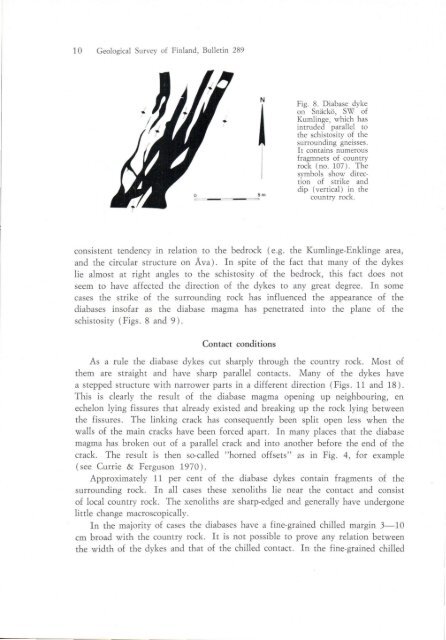Geological Survey of Finland Bulletin 289 - arkisto.gsf.fi
Geological Survey of Finland Bulletin 289 - arkisto.gsf.fi
Geological Survey of Finland Bulletin 289 - arkisto.gsf.fi
You also want an ePaper? Increase the reach of your titles
YUMPU automatically turns print PDFs into web optimized ePapers that Google loves.
10 <strong>Geological</strong> <strong>Survey</strong> <strong>of</strong> <strong>Finland</strong>, <strong>Bulletin</strong> <strong>289</strong><br />
N<br />
Fig. 8. Diabase dyke<br />
on Snäckö, SW <strong>of</strong><br />
Kumlinge, which has<br />
intruded parallel to<br />
the schistosity <strong>of</strong> the<br />
surrounding gneisses.<br />
Il conlains numerous<br />
fragmnets <strong>of</strong> coun try<br />
rock (no. 107). The<br />
symbols show direclion<br />
<strong>of</strong> strike and<br />
dip (vertical) in the<br />
country rock.<br />
consistent tendency in relation to the bedrock (e.g. the Kumlinge-Enklinge area,<br />
and the circular structure on Äva) _ In spite <strong>of</strong> the fact that many <strong>of</strong> the dykes<br />
lie almost at right angles to the schistosity <strong>of</strong> the bedrock, this fact does not<br />
seem to have affected the direction <strong>of</strong> the dykes to any great degree_ In some<br />
ca ses the strike <strong>of</strong> the surrounding rock has influenced the appearance <strong>of</strong> the<br />
diabases insoEar as the diabase magma has penetrated into the plane oE the<br />
schistosity (Figs. 8 and 9) .<br />
Contact conditions<br />
As a rule the diabase dykes cut sharply through the country rock. Most oE<br />
them are straight and have sharp parallel contacts. Many <strong>of</strong> the dykes have<br />
a stepped structure with narrower parts in a different direction (Figs. 11 and 18).<br />
This is c1early the result oE the diabase magma opening up neighbouring, en<br />
echelon lying <strong>fi</strong>ssures that already existed and breaking up the rock lying between<br />
the <strong>fi</strong>ssures. The linking crack has consequently been split open less when the<br />
walls oE the main cracks have been forced apart. In many places that the diabase<br />
magma has broken out <strong>of</strong> a parallel crack and into another before the end <strong>of</strong> the<br />
crack. The result is then so-called "horned <strong>of</strong>fsets" as in Fig. 4, for example<br />
(see Currie & Ferguson 1970).<br />
Approximately 11 per cent oE the diabase dykes contain fragments <strong>of</strong> the<br />
surrounding rock. In all cases these xenoliths lie near the contact and consist<br />
<strong>of</strong> local country rock. The xenoliths are sharp-edged and generally have undergone<br />
litde change macroscopicall y.<br />
In the majority <strong>of</strong> cases the diabases have a <strong>fi</strong>ne-grained chilled margin 3-10<br />
cm broad wirh the country rock. It is not possible to prove any relation between<br />
the width oE the dykes and that oE the chilled contact. In the <strong>fi</strong>ne-grained chilled

















